2806NRS - Critical Evaluation of IV Catheter Research for Nursing
VerifiedAdded on 2023/04/05
|11
|2466
|499
Report
AI Summary
This report provides a critical evaluation of a research article focusing on the use of skin glue to reduce the failure rate of peripheral intravenous catheters (PICs). The evaluation includes an analysis of the study's problem, intervention, comparator, and outcomes using the PICO framework. It assesses the journal's credibility, the authors' expertise, and the quality of the title, abstract, and literature review. The report examines the research design, sampling methods, data collection techniques, and data analysis, highlighting the use of a randomized controlled trial to minimize bias. The findings indicate a statistically significant reduction in PIC failure with the use of skin glue, suggesting its potential benefits in clinical nursing practice, including improved patient comfort, reduced costs, and enhanced healthcare access. The evaluation concludes that the study is relevant to nursing practice, aligning with existing evidence and offering insights for healthcare providers to improve PIC insertion techniques and patient outcomes. Desklib offers a wealth of similar solved assignments and study resources for students.

Running head: Nursing 1
Research in Nursing
By:
Student ID:
Course No:
Tutor:
Date:
Research in Nursing
By:
Student ID:
Course No:
Tutor:
Date:
Paraphrase This Document
Need a fresh take? Get an instant paraphrase of this document with our AI Paraphraser
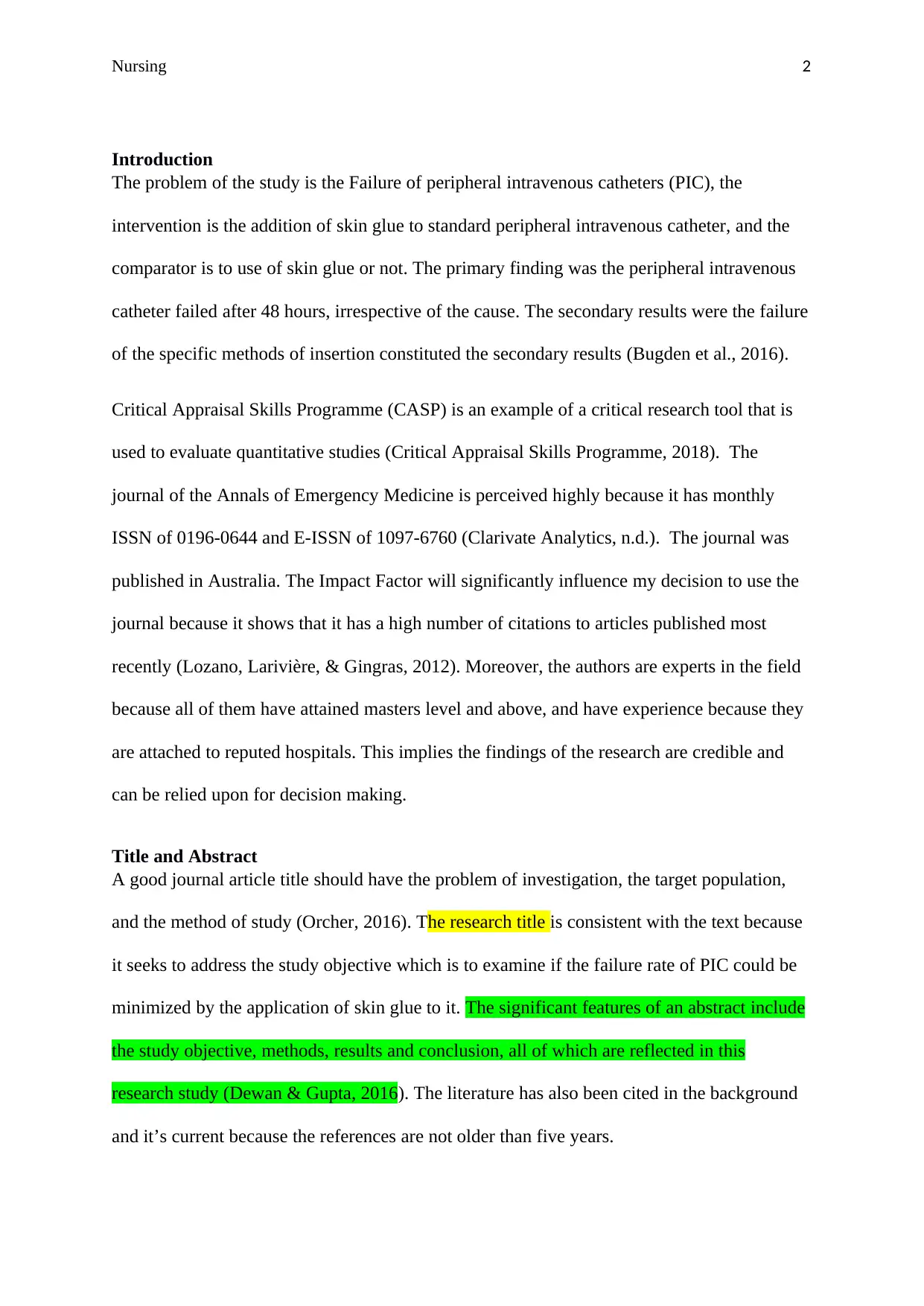
Nursing 2
Introduction
The problem of the study is the Failure of peripheral intravenous catheters (PIC), the
intervention is the addition of skin glue to standard peripheral intravenous catheter, and the
comparator is to use of skin glue or not. The primary finding was the peripheral intravenous
catheter failed after 48 hours, irrespective of the cause. The secondary results were the failure
of the specific methods of insertion constituted the secondary results (Bugden et al., 2016).
Critical Appraisal Skills Programme (CASP) is an example of a critical research tool that is
used to evaluate quantitative studies (Critical Appraisal Skills Programme, 2018). The
journal of the Annals of Emergency Medicine is perceived highly because it has monthly
ISSN of 0196-0644 and E-ISSN of 1097-6760 (Clarivate Analytics, n.d.). The journal was
published in Australia. The Impact Factor will significantly influence my decision to use the
journal because it shows that it has a high number of citations to articles published most
recently (Lozano, Larivière, & Gingras, 2012). Moreover, the authors are experts in the field
because all of them have attained masters level and above, and have experience because they
are attached to reputed hospitals. This implies the findings of the research are credible and
can be relied upon for decision making.
Title and Abstract
A good journal article title should have the problem of investigation, the target population,
and the method of study (Orcher, 2016). The research title is consistent with the text because
it seeks to address the study objective which is to examine if the failure rate of PIC could be
minimized by the application of skin glue to it. The significant features of an abstract include
the study objective, methods, results and conclusion, all of which are reflected in this
research study (Dewan & Gupta, 2016). The literature has also been cited in the background
and it’s current because the references are not older than five years.
Introduction
The problem of the study is the Failure of peripheral intravenous catheters (PIC), the
intervention is the addition of skin glue to standard peripheral intravenous catheter, and the
comparator is to use of skin glue or not. The primary finding was the peripheral intravenous
catheter failed after 48 hours, irrespective of the cause. The secondary results were the failure
of the specific methods of insertion constituted the secondary results (Bugden et al., 2016).
Critical Appraisal Skills Programme (CASP) is an example of a critical research tool that is
used to evaluate quantitative studies (Critical Appraisal Skills Programme, 2018). The
journal of the Annals of Emergency Medicine is perceived highly because it has monthly
ISSN of 0196-0644 and E-ISSN of 1097-6760 (Clarivate Analytics, n.d.). The journal was
published in Australia. The Impact Factor will significantly influence my decision to use the
journal because it shows that it has a high number of citations to articles published most
recently (Lozano, Larivière, & Gingras, 2012). Moreover, the authors are experts in the field
because all of them have attained masters level and above, and have experience because they
are attached to reputed hospitals. This implies the findings of the research are credible and
can be relied upon for decision making.
Title and Abstract
A good journal article title should have the problem of investigation, the target population,
and the method of study (Orcher, 2016). The research title is consistent with the text because
it seeks to address the study objective which is to examine if the failure rate of PIC could be
minimized by the application of skin glue to it. The significant features of an abstract include
the study objective, methods, results and conclusion, all of which are reflected in this
research study (Dewan & Gupta, 2016). The literature has also been cited in the background
and it’s current because the references are not older than five years.
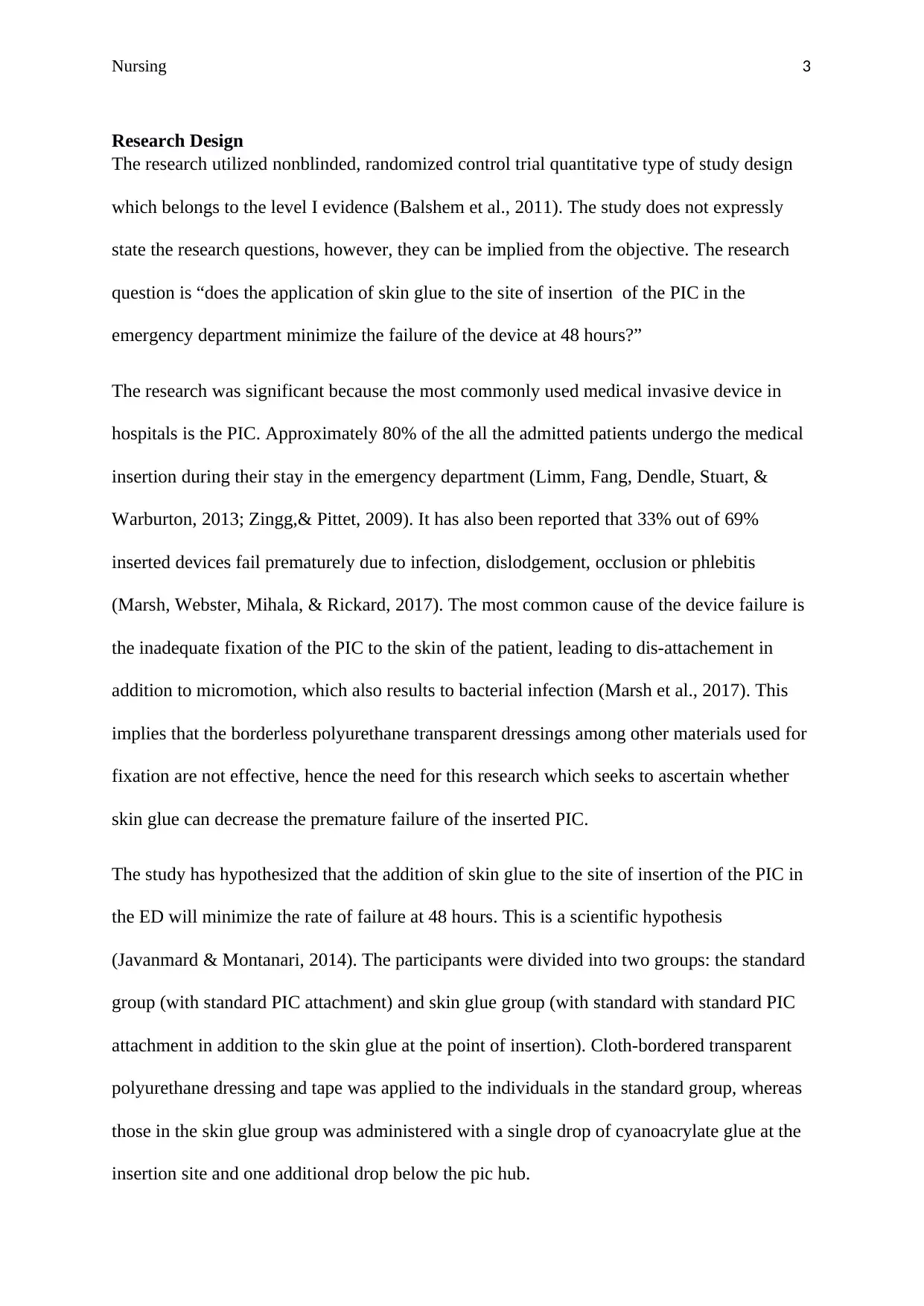
Nursing 3
Research Design
The research utilized nonblinded, randomized control trial quantitative type of study design
which belongs to the level I evidence (Balshem et al., 2011). The study does not expressly
state the research questions, however, they can be implied from the objective. The research
question is “does the application of skin glue to the site of insertion of the PIC in the
emergency department minimize the failure of the device at 48 hours?”
The research was significant because the most commonly used medical invasive device in
hospitals is the PIC. Approximately 80% of the all the admitted patients undergo the medical
insertion during their stay in the emergency department (Limm, Fang, Dendle, Stuart, &
Warburton, 2013; Zingg,& Pittet, 2009). It has also been reported that 33% out of 69%
inserted devices fail prematurely due to infection, dislodgement, occlusion or phlebitis
(Marsh, Webster, Mihala, & Rickard, 2017). The most common cause of the device failure is
the inadequate fixation of the PIC to the skin of the patient, leading to dis-attachement in
addition to micromotion, which also results to bacterial infection (Marsh et al., 2017). This
implies that the borderless polyurethane transparent dressings among other materials used for
fixation are not effective, hence the need for this research which seeks to ascertain whether
skin glue can decrease the premature failure of the inserted PIC.
The study has hypothesized that the addition of skin glue to the site of insertion of the PIC in
the ED will minimize the rate of failure at 48 hours. This is a scientific hypothesis
(Javanmard & Montanari, 2014). The participants were divided into two groups: the standard
group (with standard PIC attachment) and skin glue group (with standard with standard PIC
attachment in addition to the skin glue at the point of insertion). Cloth-bordered transparent
polyurethane dressing and tape was applied to the individuals in the standard group, whereas
those in the skin glue group was administered with a single drop of cyanoacrylate glue at the
insertion site and one additional drop below the pic hub.
Research Design
The research utilized nonblinded, randomized control trial quantitative type of study design
which belongs to the level I evidence (Balshem et al., 2011). The study does not expressly
state the research questions, however, they can be implied from the objective. The research
question is “does the application of skin glue to the site of insertion of the PIC in the
emergency department minimize the failure of the device at 48 hours?”
The research was significant because the most commonly used medical invasive device in
hospitals is the PIC. Approximately 80% of the all the admitted patients undergo the medical
insertion during their stay in the emergency department (Limm, Fang, Dendle, Stuart, &
Warburton, 2013; Zingg,& Pittet, 2009). It has also been reported that 33% out of 69%
inserted devices fail prematurely due to infection, dislodgement, occlusion or phlebitis
(Marsh, Webster, Mihala, & Rickard, 2017). The most common cause of the device failure is
the inadequate fixation of the PIC to the skin of the patient, leading to dis-attachement in
addition to micromotion, which also results to bacterial infection (Marsh et al., 2017). This
implies that the borderless polyurethane transparent dressings among other materials used for
fixation are not effective, hence the need for this research which seeks to ascertain whether
skin glue can decrease the premature failure of the inserted PIC.
The study has hypothesized that the addition of skin glue to the site of insertion of the PIC in
the ED will minimize the rate of failure at 48 hours. This is a scientific hypothesis
(Javanmard & Montanari, 2014). The participants were divided into two groups: the standard
group (with standard PIC attachment) and skin glue group (with standard with standard PIC
attachment in addition to the skin glue at the point of insertion). Cloth-bordered transparent
polyurethane dressing and tape was applied to the individuals in the standard group, whereas
those in the skin glue group was administered with a single drop of cyanoacrylate glue at the
insertion site and one additional drop below the pic hub.
⊘ This is a preview!⊘
Do you want full access?
Subscribe today to unlock all pages.

Trusted by 1+ million students worldwide
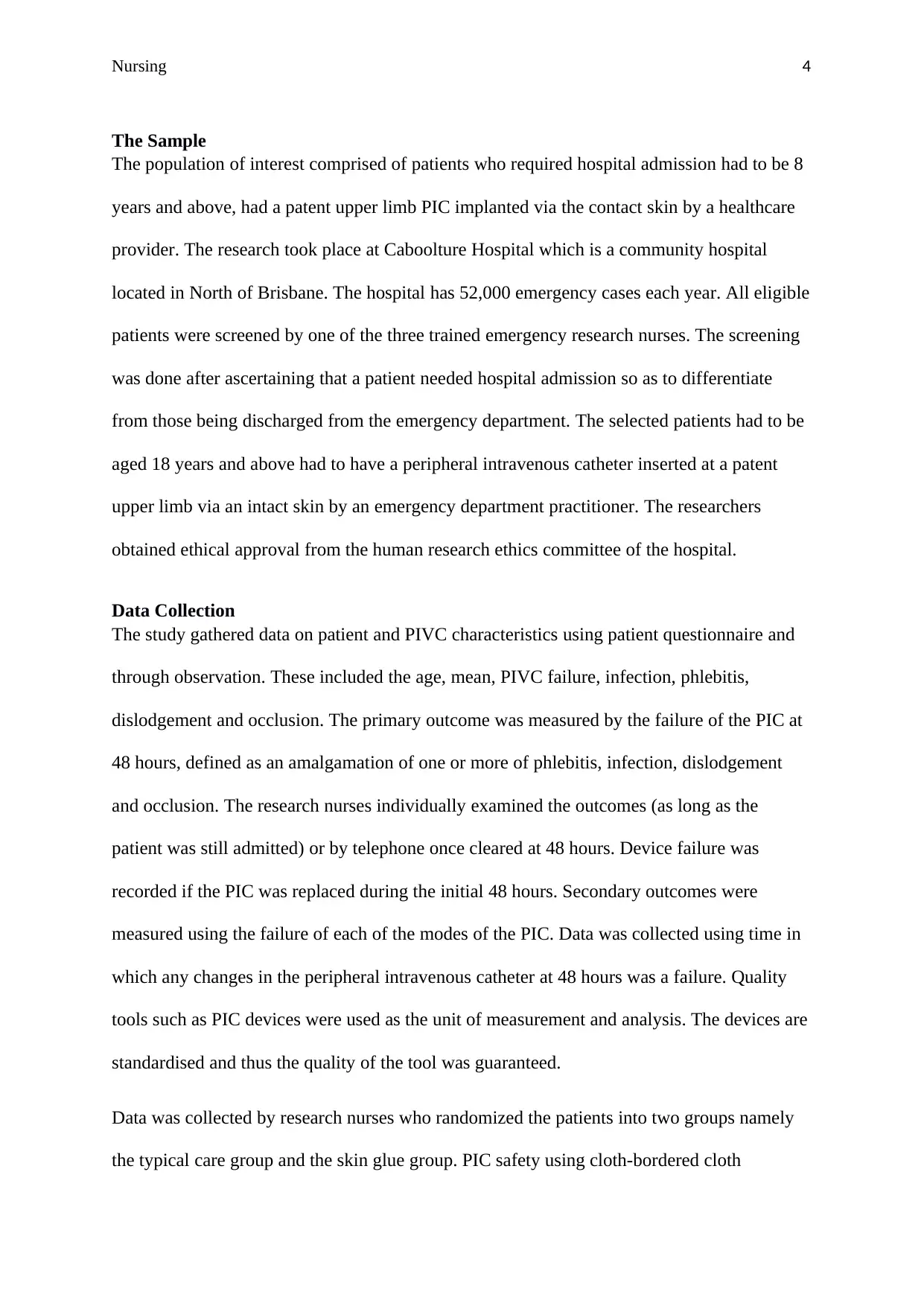
Nursing 4
The Sample
The population of interest comprised of patients who required hospital admission had to be 8
years and above, had a patent upper limb PIC implanted via the contact skin by a healthcare
provider. The research took place at Caboolture Hospital which is a community hospital
located in North of Brisbane. The hospital has 52,000 emergency cases each year. All eligible
patients were screened by one of the three trained emergency research nurses. The screening
was done after ascertaining that a patient needed hospital admission so as to differentiate
from those being discharged from the emergency department. The selected patients had to be
aged 18 years and above had to have a peripheral intravenous catheter inserted at a patent
upper limb via an intact skin by an emergency department practitioner. The researchers
obtained ethical approval from the human research ethics committee of the hospital.
Data Collection
The study gathered data on patient and PIVC characteristics using patient questionnaire and
through observation. These included the age, mean, PIVC failure, infection, phlebitis,
dislodgement and occlusion. The primary outcome was measured by the failure of the PIC at
48 hours, defined as an amalgamation of one or more of phlebitis, infection, dislodgement
and occlusion. The research nurses individually examined the outcomes (as long as the
patient was still admitted) or by telephone once cleared at 48 hours. Device failure was
recorded if the PIC was replaced during the initial 48 hours. Secondary outcomes were
measured using the failure of each of the modes of the PIC. Data was collected using time in
which any changes in the peripheral intravenous catheter at 48 hours was a failure. Quality
tools such as PIC devices were used as the unit of measurement and analysis. The devices are
standardised and thus the quality of the tool was guaranteed.
Data was collected by research nurses who randomized the patients into two groups namely
the typical care group and the skin glue group. PIC safety using cloth-bordered cloth
The Sample
The population of interest comprised of patients who required hospital admission had to be 8
years and above, had a patent upper limb PIC implanted via the contact skin by a healthcare
provider. The research took place at Caboolture Hospital which is a community hospital
located in North of Brisbane. The hospital has 52,000 emergency cases each year. All eligible
patients were screened by one of the three trained emergency research nurses. The screening
was done after ascertaining that a patient needed hospital admission so as to differentiate
from those being discharged from the emergency department. The selected patients had to be
aged 18 years and above had to have a peripheral intravenous catheter inserted at a patent
upper limb via an intact skin by an emergency department practitioner. The researchers
obtained ethical approval from the human research ethics committee of the hospital.
Data Collection
The study gathered data on patient and PIVC characteristics using patient questionnaire and
through observation. These included the age, mean, PIVC failure, infection, phlebitis,
dislodgement and occlusion. The primary outcome was measured by the failure of the PIC at
48 hours, defined as an amalgamation of one or more of phlebitis, infection, dislodgement
and occlusion. The research nurses individually examined the outcomes (as long as the
patient was still admitted) or by telephone once cleared at 48 hours. Device failure was
recorded if the PIC was replaced during the initial 48 hours. Secondary outcomes were
measured using the failure of each of the modes of the PIC. Data was collected using time in
which any changes in the peripheral intravenous catheter at 48 hours was a failure. Quality
tools such as PIC devices were used as the unit of measurement and analysis. The devices are
standardised and thus the quality of the tool was guaranteed.
Data was collected by research nurses who randomized the patients into two groups namely
the typical care group and the skin glue group. PIC safety using cloth-bordered cloth
Paraphrase This Document
Need a fresh take? Get an instant paraphrase of this document with our AI Paraphraser
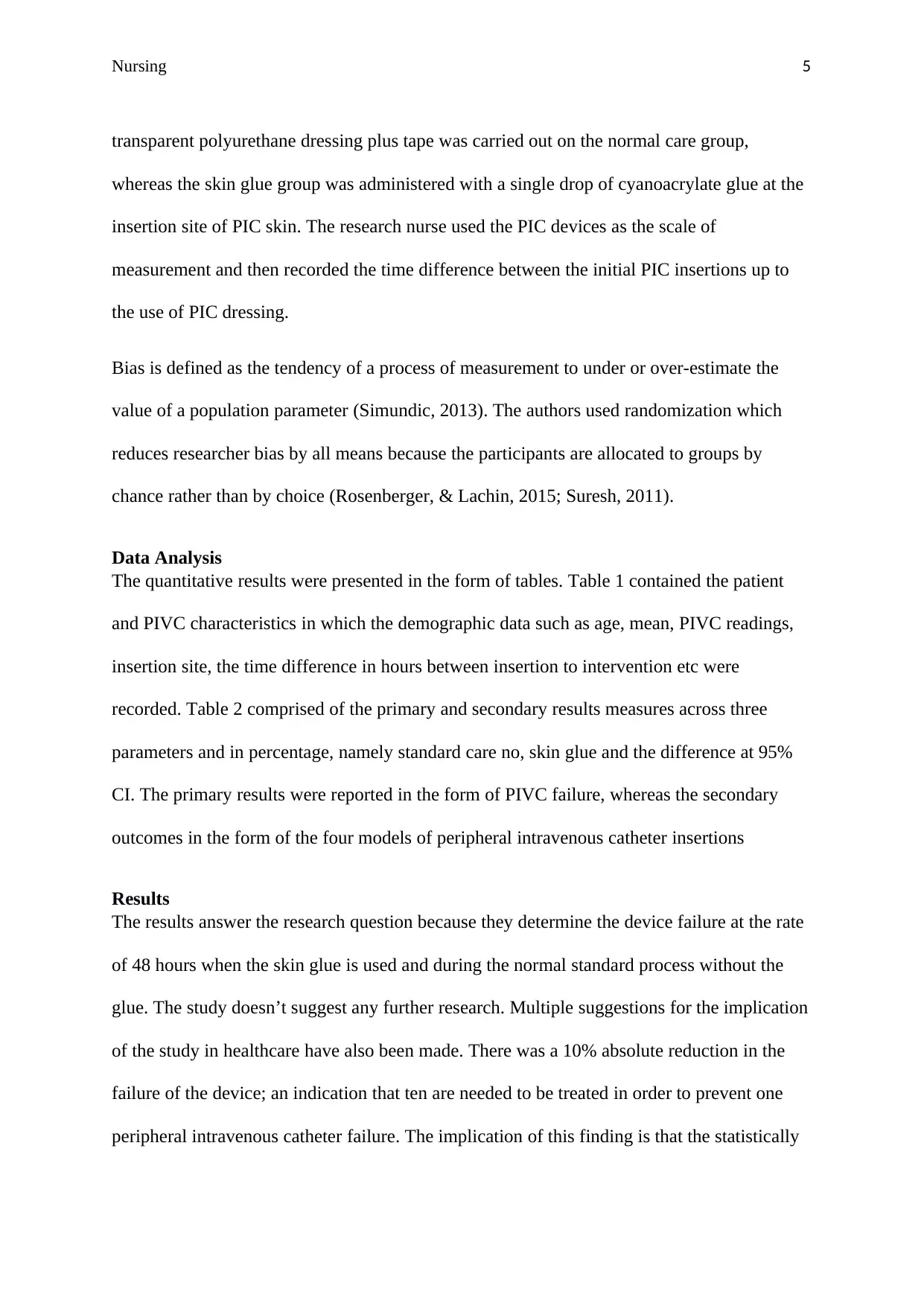
Nursing 5
transparent polyurethane dressing plus tape was carried out on the normal care group,
whereas the skin glue group was administered with a single drop of cyanoacrylate glue at the
insertion site of PIC skin. The research nurse used the PIC devices as the scale of
measurement and then recorded the time difference between the initial PIC insertions up to
the use of PIC dressing.
Bias is defined as the tendency of a process of measurement to under or over-estimate the
value of a population parameter (Simundic, 2013). The authors used randomization which
reduces researcher bias by all means because the participants are allocated to groups by
chance rather than by choice (Rosenberger, & Lachin, 2015; Suresh, 2011).
Data Analysis
The quantitative results were presented in the form of tables. Table 1 contained the patient
and PIVC characteristics in which the demographic data such as age, mean, PIVC readings,
insertion site, the time difference in hours between insertion to intervention etc were
recorded. Table 2 comprised of the primary and secondary results measures across three
parameters and in percentage, namely standard care no, skin glue and the difference at 95%
CI. The primary results were reported in the form of PIVC failure, whereas the secondary
outcomes in the form of the four models of peripheral intravenous catheter insertions
Results
The results answer the research question because they determine the device failure at the rate
of 48 hours when the skin glue is used and during the normal standard process without the
glue. The study doesn’t suggest any further research. Multiple suggestions for the implication
of the study in healthcare have also been made. There was a 10% absolute reduction in the
failure of the device; an indication that ten are needed to be treated in order to prevent one
peripheral intravenous catheter failure. The implication of this finding is that the statistically
transparent polyurethane dressing plus tape was carried out on the normal care group,
whereas the skin glue group was administered with a single drop of cyanoacrylate glue at the
insertion site of PIC skin. The research nurse used the PIC devices as the scale of
measurement and then recorded the time difference between the initial PIC insertions up to
the use of PIC dressing.
Bias is defined as the tendency of a process of measurement to under or over-estimate the
value of a population parameter (Simundic, 2013). The authors used randomization which
reduces researcher bias by all means because the participants are allocated to groups by
chance rather than by choice (Rosenberger, & Lachin, 2015; Suresh, 2011).
Data Analysis
The quantitative results were presented in the form of tables. Table 1 contained the patient
and PIVC characteristics in which the demographic data such as age, mean, PIVC readings,
insertion site, the time difference in hours between insertion to intervention etc were
recorded. Table 2 comprised of the primary and secondary results measures across three
parameters and in percentage, namely standard care no, skin glue and the difference at 95%
CI. The primary results were reported in the form of PIVC failure, whereas the secondary
outcomes in the form of the four models of peripheral intravenous catheter insertions
Results
The results answer the research question because they determine the device failure at the rate
of 48 hours when the skin glue is used and during the normal standard process without the
glue. The study doesn’t suggest any further research. Multiple suggestions for the implication
of the study in healthcare have also been made. There was a 10% absolute reduction in the
failure of the device; an indication that ten are needed to be treated in order to prevent one
peripheral intravenous catheter failure. The implication of this finding is that the statistically
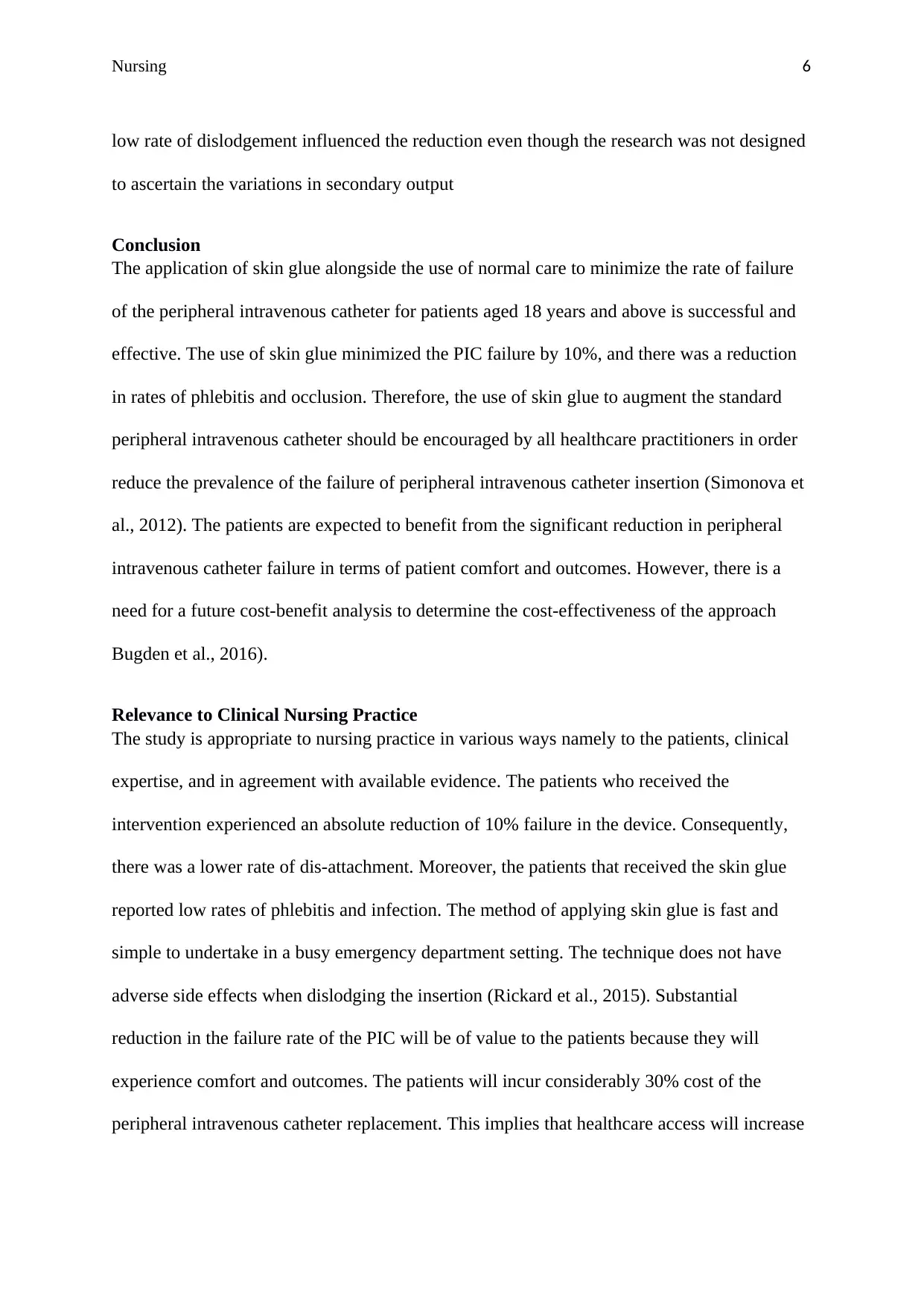
Nursing 6
low rate of dislodgement influenced the reduction even though the research was not designed
to ascertain the variations in secondary output
Conclusion
The application of skin glue alongside the use of normal care to minimize the rate of failure
of the peripheral intravenous catheter for patients aged 18 years and above is successful and
effective. The use of skin glue minimized the PIC failure by 10%, and there was a reduction
in rates of phlebitis and occlusion. Therefore, the use of skin glue to augment the standard
peripheral intravenous catheter should be encouraged by all healthcare practitioners in order
reduce the prevalence of the failure of peripheral intravenous catheter insertion (Simonova et
al., 2012). The patients are expected to benefit from the significant reduction in peripheral
intravenous catheter failure in terms of patient comfort and outcomes. However, there is a
need for a future cost-benefit analysis to determine the cost-effectiveness of the approach
Bugden et al., 2016).
Relevance to Clinical Nursing Practice
The study is appropriate to nursing practice in various ways namely to the patients, clinical
expertise, and in agreement with available evidence. The patients who received the
intervention experienced an absolute reduction of 10% failure in the device. Consequently,
there was a lower rate of dis-attachment. Moreover, the patients that received the skin glue
reported low rates of phlebitis and infection. The method of applying skin glue is fast and
simple to undertake in a busy emergency department setting. The technique does not have
adverse side effects when dislodging the insertion (Rickard et al., 2015). Substantial
reduction in the failure rate of the PIC will be of value to the patients because they will
experience comfort and outcomes. The patients will incur considerably 30% cost of the
peripheral intravenous catheter replacement. This implies that healthcare access will increase
low rate of dislodgement influenced the reduction even though the research was not designed
to ascertain the variations in secondary output
Conclusion
The application of skin glue alongside the use of normal care to minimize the rate of failure
of the peripheral intravenous catheter for patients aged 18 years and above is successful and
effective. The use of skin glue minimized the PIC failure by 10%, and there was a reduction
in rates of phlebitis and occlusion. Therefore, the use of skin glue to augment the standard
peripheral intravenous catheter should be encouraged by all healthcare practitioners in order
reduce the prevalence of the failure of peripheral intravenous catheter insertion (Simonova et
al., 2012). The patients are expected to benefit from the significant reduction in peripheral
intravenous catheter failure in terms of patient comfort and outcomes. However, there is a
need for a future cost-benefit analysis to determine the cost-effectiveness of the approach
Bugden et al., 2016).
Relevance to Clinical Nursing Practice
The study is appropriate to nursing practice in various ways namely to the patients, clinical
expertise, and in agreement with available evidence. The patients who received the
intervention experienced an absolute reduction of 10% failure in the device. Consequently,
there was a lower rate of dis-attachment. Moreover, the patients that received the skin glue
reported low rates of phlebitis and infection. The method of applying skin glue is fast and
simple to undertake in a busy emergency department setting. The technique does not have
adverse side effects when dislodging the insertion (Rickard et al., 2015). Substantial
reduction in the failure rate of the PIC will be of value to the patients because they will
experience comfort and outcomes. The patients will incur considerably 30% cost of the
peripheral intravenous catheter replacement. This implies that healthcare access will increase
⊘ This is a preview!⊘
Do you want full access?
Subscribe today to unlock all pages.

Trusted by 1+ million students worldwide
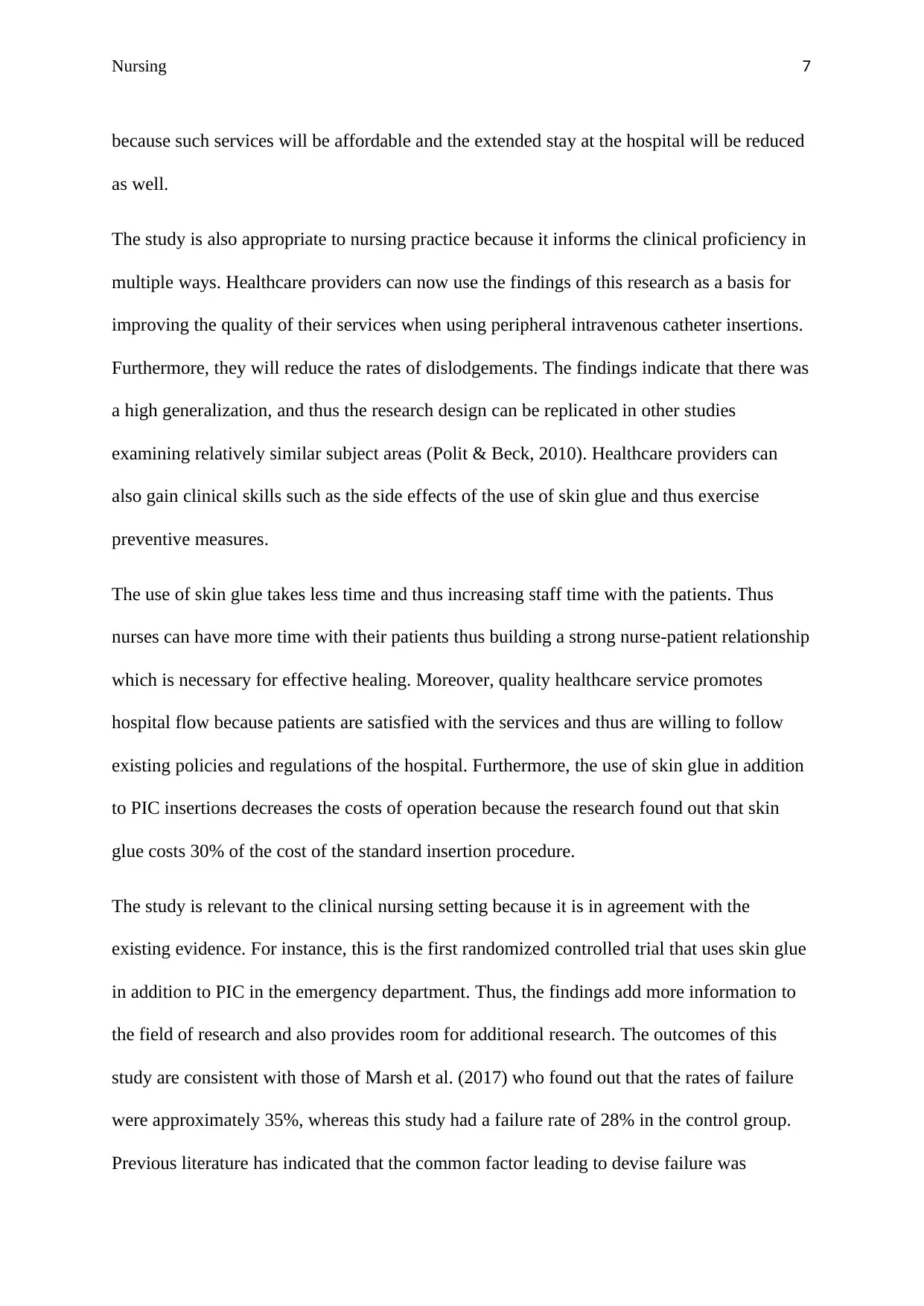
Nursing 7
because such services will be affordable and the extended stay at the hospital will be reduced
as well.
The study is also appropriate to nursing practice because it informs the clinical proficiency in
multiple ways. Healthcare providers can now use the findings of this research as a basis for
improving the quality of their services when using peripheral intravenous catheter insertions.
Furthermore, they will reduce the rates of dislodgements. The findings indicate that there was
a high generalization, and thus the research design can be replicated in other studies
examining relatively similar subject areas (Polit & Beck, 2010). Healthcare providers can
also gain clinical skills such as the side effects of the use of skin glue and thus exercise
preventive measures.
The use of skin glue takes less time and thus increasing staff time with the patients. Thus
nurses can have more time with their patients thus building a strong nurse-patient relationship
which is necessary for effective healing. Moreover, quality healthcare service promotes
hospital flow because patients are satisfied with the services and thus are willing to follow
existing policies and regulations of the hospital. Furthermore, the use of skin glue in addition
to PIC insertions decreases the costs of operation because the research found out that skin
glue costs 30% of the cost of the standard insertion procedure.
The study is relevant to the clinical nursing setting because it is in agreement with the
existing evidence. For instance, this is the first randomized controlled trial that uses skin glue
in addition to PIC in the emergency department. Thus, the findings add more information to
the field of research and also provides room for additional research. The outcomes of this
study are consistent with those of Marsh et al. (2017) who found out that the rates of failure
were approximately 35%, whereas this study had a failure rate of 28% in the control group.
Previous literature has indicated that the common factor leading to devise failure was
because such services will be affordable and the extended stay at the hospital will be reduced
as well.
The study is also appropriate to nursing practice because it informs the clinical proficiency in
multiple ways. Healthcare providers can now use the findings of this research as a basis for
improving the quality of their services when using peripheral intravenous catheter insertions.
Furthermore, they will reduce the rates of dislodgements. The findings indicate that there was
a high generalization, and thus the research design can be replicated in other studies
examining relatively similar subject areas (Polit & Beck, 2010). Healthcare providers can
also gain clinical skills such as the side effects of the use of skin glue and thus exercise
preventive measures.
The use of skin glue takes less time and thus increasing staff time with the patients. Thus
nurses can have more time with their patients thus building a strong nurse-patient relationship
which is necessary for effective healing. Moreover, quality healthcare service promotes
hospital flow because patients are satisfied with the services and thus are willing to follow
existing policies and regulations of the hospital. Furthermore, the use of skin glue in addition
to PIC insertions decreases the costs of operation because the research found out that skin
glue costs 30% of the cost of the standard insertion procedure.
The study is relevant to the clinical nursing setting because it is in agreement with the
existing evidence. For instance, this is the first randomized controlled trial that uses skin glue
in addition to PIC in the emergency department. Thus, the findings add more information to
the field of research and also provides room for additional research. The outcomes of this
study are consistent with those of Marsh et al. (2017) who found out that the rates of failure
were approximately 35%, whereas this study had a failure rate of 28% in the control group.
Previous literature has indicated that the common factor leading to devise failure was
Paraphrase This Document
Need a fresh take? Get an instant paraphrase of this document with our AI Paraphraser

Nursing 8
insufficient sticking of the PIC to the skin of the patient leading to dis-attachment and
bacterial infection (Marsh et al., 2017). The findings of this study are consistent with those of
3 because this study found out that the addition of skin glue to the insertion significantly
reduced the rate of device failure by 10%.
insufficient sticking of the PIC to the skin of the patient leading to dis-attachment and
bacterial infection (Marsh et al., 2017). The findings of this study are consistent with those of
3 because this study found out that the addition of skin glue to the insertion significantly
reduced the rate of device failure by 10%.
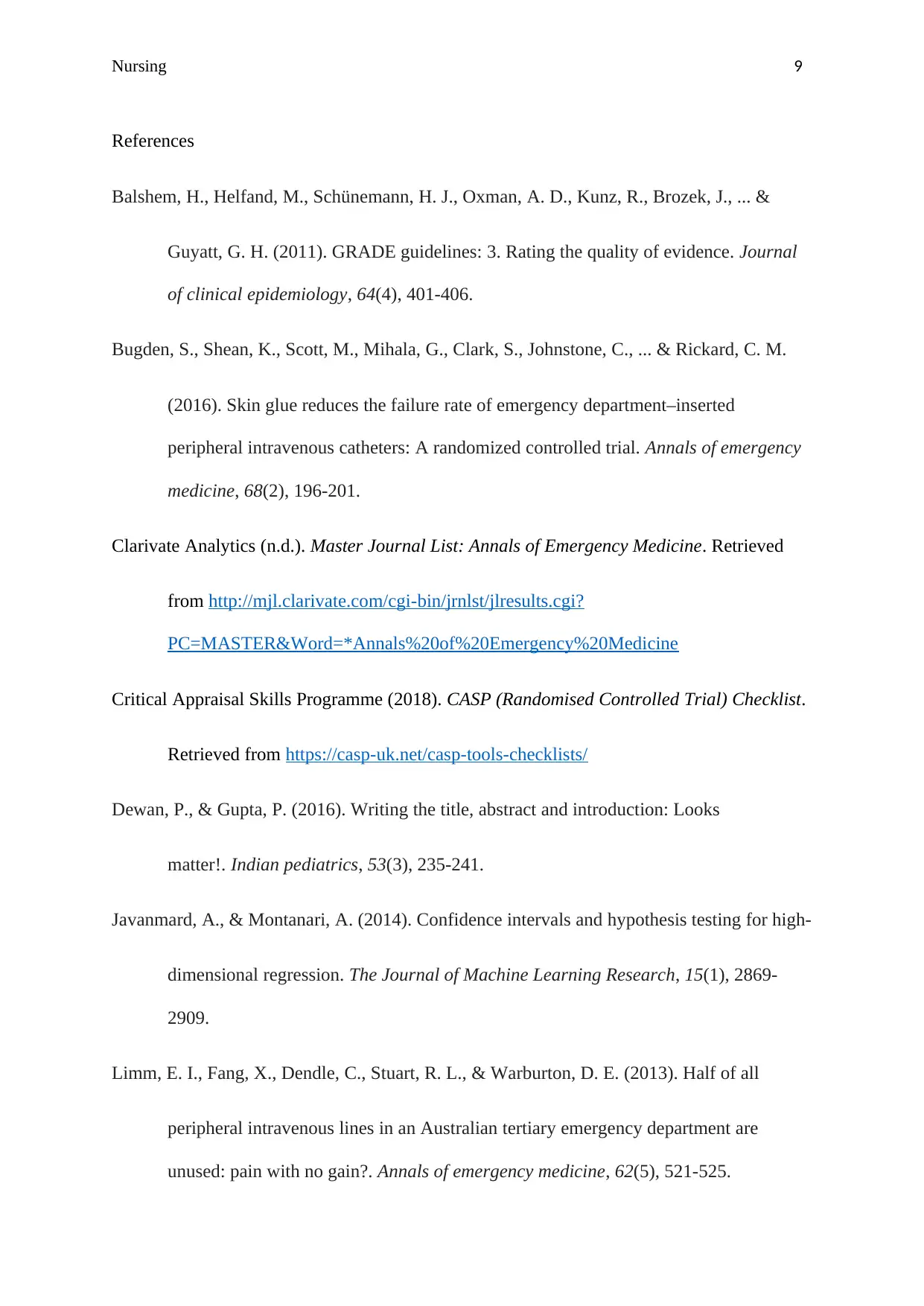
Nursing 9
References
Balshem, H., Helfand, M., Schünemann, H. J., Oxman, A. D., Kunz, R., Brozek, J., ... &
Guyatt, G. H. (2011). GRADE guidelines: 3. Rating the quality of evidence. Journal
of clinical epidemiology, 64(4), 401-406.
Bugden, S., Shean, K., Scott, M., Mihala, G., Clark, S., Johnstone, C., ... & Rickard, C. M.
(2016). Skin glue reduces the failure rate of emergency department–inserted
peripheral intravenous catheters: A randomized controlled trial. Annals of emergency
medicine, 68(2), 196-201.
Clarivate Analytics (n.d.). Master Journal List: Annals of Emergency Medicine. Retrieved
from http://mjl.clarivate.com/cgi-bin/jrnlst/jlresults.cgi?
PC=MASTER&Word=*Annals%20of%20Emergency%20Medicine
Critical Appraisal Skills Programme (2018). CASP (Randomised Controlled Trial) Checklist.
Retrieved from https://casp-uk.net/casp-tools-checklists/
Dewan, P., & Gupta, P. (2016). Writing the title, abstract and introduction: Looks
matter!. Indian pediatrics, 53(3), 235-241.
Javanmard, A., & Montanari, A. (2014). Confidence intervals and hypothesis testing for high-
dimensional regression. The Journal of Machine Learning Research, 15(1), 2869-
2909.
Limm, E. I., Fang, X., Dendle, C., Stuart, R. L., & Warburton, D. E. (2013). Half of all
peripheral intravenous lines in an Australian tertiary emergency department are
unused: pain with no gain?. Annals of emergency medicine, 62(5), 521-525.
References
Balshem, H., Helfand, M., Schünemann, H. J., Oxman, A. D., Kunz, R., Brozek, J., ... &
Guyatt, G. H. (2011). GRADE guidelines: 3. Rating the quality of evidence. Journal
of clinical epidemiology, 64(4), 401-406.
Bugden, S., Shean, K., Scott, M., Mihala, G., Clark, S., Johnstone, C., ... & Rickard, C. M.
(2016). Skin glue reduces the failure rate of emergency department–inserted
peripheral intravenous catheters: A randomized controlled trial. Annals of emergency
medicine, 68(2), 196-201.
Clarivate Analytics (n.d.). Master Journal List: Annals of Emergency Medicine. Retrieved
from http://mjl.clarivate.com/cgi-bin/jrnlst/jlresults.cgi?
PC=MASTER&Word=*Annals%20of%20Emergency%20Medicine
Critical Appraisal Skills Programme (2018). CASP (Randomised Controlled Trial) Checklist.
Retrieved from https://casp-uk.net/casp-tools-checklists/
Dewan, P., & Gupta, P. (2016). Writing the title, abstract and introduction: Looks
matter!. Indian pediatrics, 53(3), 235-241.
Javanmard, A., & Montanari, A. (2014). Confidence intervals and hypothesis testing for high-
dimensional regression. The Journal of Machine Learning Research, 15(1), 2869-
2909.
Limm, E. I., Fang, X., Dendle, C., Stuart, R. L., & Warburton, D. E. (2013). Half of all
peripheral intravenous lines in an Australian tertiary emergency department are
unused: pain with no gain?. Annals of emergency medicine, 62(5), 521-525.
⊘ This is a preview!⊘
Do you want full access?
Subscribe today to unlock all pages.

Trusted by 1+ million students worldwide
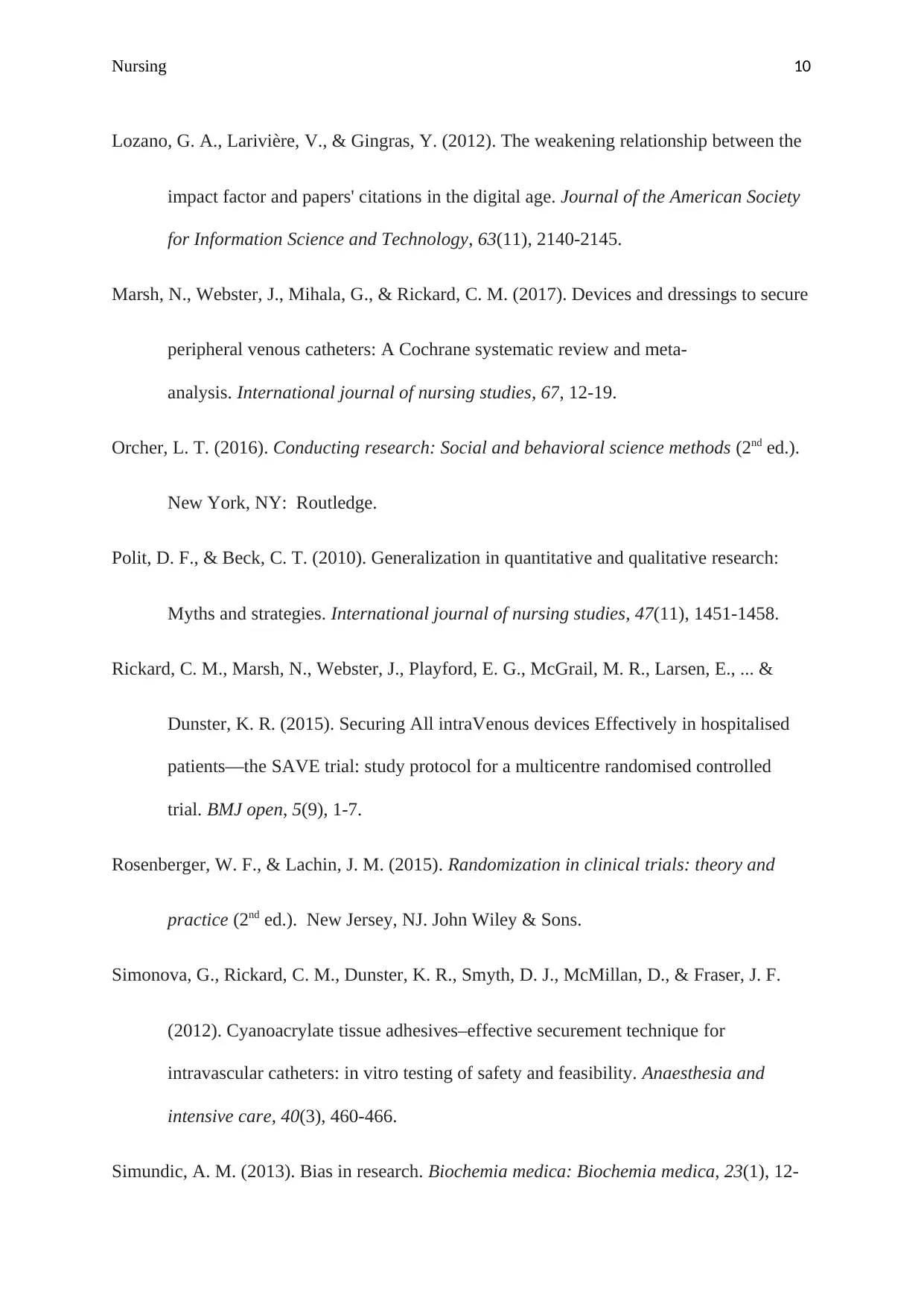
Nursing 10
Lozano, G. A., Larivière, V., & Gingras, Y. (2012). The weakening relationship between the
impact factor and papers' citations in the digital age. Journal of the American Society
for Information Science and Technology, 63(11), 2140-2145.
Marsh, N., Webster, J., Mihala, G., & Rickard, C. M. (2017). Devices and dressings to secure
peripheral venous catheters: A Cochrane systematic review and meta-
analysis. International journal of nursing studies, 67, 12-19.
Orcher, L. T. (2016). Conducting research: Social and behavioral science methods (2nd ed.).
New York, NY: Routledge.
Polit, D. F., & Beck, C. T. (2010). Generalization in quantitative and qualitative research:
Myths and strategies. International journal of nursing studies, 47(11), 1451-1458.
Rickard, C. M., Marsh, N., Webster, J., Playford, E. G., McGrail, M. R., Larsen, E., ... &
Dunster, K. R. (2015). Securing All intraVenous devices Effectively in hospitalised
patients—the SAVE trial: study protocol for a multicentre randomised controlled
trial. BMJ open, 5(9), 1-7.
Rosenberger, W. F., & Lachin, J. M. (2015). Randomization in clinical trials: theory and
practice (2nd ed.). New Jersey, NJ. John Wiley & Sons.
Simonova, G., Rickard, C. M., Dunster, K. R., Smyth, D. J., McMillan, D., & Fraser, J. F.
(2012). Cyanoacrylate tissue adhesives–effective securement technique for
intravascular catheters: in vitro testing of safety and feasibility. Anaesthesia and
intensive care, 40(3), 460-466.
Simundic, A. M. (2013). Bias in research. Biochemia medica: Biochemia medica, 23(1), 12-
Lozano, G. A., Larivière, V., & Gingras, Y. (2012). The weakening relationship between the
impact factor and papers' citations in the digital age. Journal of the American Society
for Information Science and Technology, 63(11), 2140-2145.
Marsh, N., Webster, J., Mihala, G., & Rickard, C. M. (2017). Devices and dressings to secure
peripheral venous catheters: A Cochrane systematic review and meta-
analysis. International journal of nursing studies, 67, 12-19.
Orcher, L. T. (2016). Conducting research: Social and behavioral science methods (2nd ed.).
New York, NY: Routledge.
Polit, D. F., & Beck, C. T. (2010). Generalization in quantitative and qualitative research:
Myths and strategies. International journal of nursing studies, 47(11), 1451-1458.
Rickard, C. M., Marsh, N., Webster, J., Playford, E. G., McGrail, M. R., Larsen, E., ... &
Dunster, K. R. (2015). Securing All intraVenous devices Effectively in hospitalised
patients—the SAVE trial: study protocol for a multicentre randomised controlled
trial. BMJ open, 5(9), 1-7.
Rosenberger, W. F., & Lachin, J. M. (2015). Randomization in clinical trials: theory and
practice (2nd ed.). New Jersey, NJ. John Wiley & Sons.
Simonova, G., Rickard, C. M., Dunster, K. R., Smyth, D. J., McMillan, D., & Fraser, J. F.
(2012). Cyanoacrylate tissue adhesives–effective securement technique for
intravascular catheters: in vitro testing of safety and feasibility. Anaesthesia and
intensive care, 40(3), 460-466.
Simundic, A. M. (2013). Bias in research. Biochemia medica: Biochemia medica, 23(1), 12-
Paraphrase This Document
Need a fresh take? Get an instant paraphrase of this document with our AI Paraphraser

Nursing 11
15.
Suresh, K. P. (2011). An overview of randomization techniques: an unbiased assessment of
outcome in clinical research. Journal of human reproductive sciences, 4(1), 8-18.
Zingg, W., & Pittet, D. (2009). Peripheral venous catheters: an under-evaluated
problem. International journal of antimicrobial agents, 34, S38-S42.
15.
Suresh, K. P. (2011). An overview of randomization techniques: an unbiased assessment of
outcome in clinical research. Journal of human reproductive sciences, 4(1), 8-18.
Zingg, W., & Pittet, D. (2009). Peripheral venous catheters: an under-evaluated
problem. International journal of antimicrobial agents, 34, S38-S42.
1 out of 11
Related Documents
Your All-in-One AI-Powered Toolkit for Academic Success.
+13062052269
info@desklib.com
Available 24*7 on WhatsApp / Email
![[object Object]](/_next/static/media/star-bottom.7253800d.svg)
Unlock your academic potential
Copyright © 2020–2025 A2Z Services. All Rights Reserved. Developed and managed by ZUCOL.





